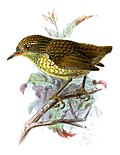| Nesoptilotis | |
|---|---|
 | |
| Nesoptilotis leucotis (white-eared honeyeater) | |
| Scientific classification | |
| Kingdom: | Animalia |
| Phylum: | Chordata |
| Class: | Aves |
| Order: | Passeriformes |
| Family: | Meliphagidae |
| Genus: | Nesoptilotis Mathews, 1913 |
| Type species | |
| Ptilotis flavigula [1] Gould, 1838 | |
Nesoptilotis is a genus of honeyeaters endemic to Australia and Tasmania. The genus consists of two former members of Lichenostomus , and was created after a molecular phylogenetic analysis published in 2011 showed that the original genus was polyphyletic. [2]
The genus contains two species: [3]
| Image | Scientific name | Common name | Distribution |
|---|---|---|---|
 | N. flavicollis | Yellow-throated honeyeater | Tasmania |
 | N. leucotis | White-eared honeyeater | southwest, south and east Australia |
The name Nesoptilotis was first proposed by the Australian ornithologist Gregory Mathews in 1913. [4] [5] The word is derived from the Greek nēsos island (i.e. Tasmania), ptilon feather and -ōtis eared. [6]
